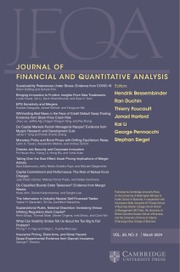No CrossRef data available.
Article contents
Foreign Exchange Order Flow as a Risk Factor
Published online by Cambridge University Press: 08 July 2025
Abstract
We propose a novel pricing factor for currency returns motivated by the market microstructure literature. Our factor aggregates order flow data to provide a measure of buying and selling pressure related to conventional currency trading strategies. It successfully prices the cross-section of currency returns sorted on the basis of forward discount and momentum. The association between our factor and currency returns differs according to the customer segment of the foreign exchange market. In particular, it appears that financial customers are risk-takers in the market, while nonfinancial customers serve as liquidity providers.
Information
- Type
- Research Article
- Information
- Journal of Financial and Quantitative Analysis , Volume 60 , Issue 5 , August 2025 , pp. 2555 - 2582
- Creative Commons
- This is an Open Access article, distributed under the terms of the Creative Commons Attribution licence (http://creativecommons.org/licenses/by/4.0), which permits unrestricted re-use, distribution and reproduction, provided the original article is properly cited.
- Copyright
- © The Author(s), 2025. Published by Cambridge University Press on behalf of the Michael G. Foster School of Business, University of Washington
Footnotes
We thank an anonymous referee, Hendrik Bessembinder (the editor), Vania Stavrakeva, and participants at the Imperial College 2019 Annual Conference in International Finance for helpful comments and suggestions.
The article has been updated since original publication. A notice detailing the change has also been published.
References
A correction has been issued for this article:
Linked content
Please note a has been issued for this article.

